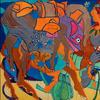James Daugherty
- NEW YORK, New York
- /
- February 09, 2012
Spanierman Modern is pleased to announce the opening on February 23, 2012 of James Daugherty, an exhibition and sale comprised of the remarkable abstract color paintings that this important twentieth-century American modernist created during the last twenty years of his life. The show brings much-deserved recognition to this overlooked phase of Daugherty's long and distinguished career. The show is accompanied by a brochure with an essay by the noted scholar William C. Agee.
James Daugherty (1887-1974) was born in Asheville, North Carolina, and grew up on farms in Ohio and Indiana before his family moved to Washington, D.C. By the time he was sixteen, he was taking evening classes at the Corcoran School of Art. He subsequently studied in Philadelphia at the Pennsylvania Academy of the Fine Arts and in New York at the National Academy of Design. In 1913 Daugherty's eyes were opened to a world of new possibilities by the landmark Armory Show and his discovery of a book by C. Lewis Hind, Post-Impressionism , which had been published in 1911. As he later described it, he "went modern with a vengeance." In the 1920s, Daugherty adopted a more figurative style while retaining his former emphasis on vibrant color. He subsequently produced numerous easel paintings and murals, and continued his mural work into the 1930s, but eventually devoted the majority of his time to illustrating children's books.
Just exactly what had inspired James Daugherty to return to abstract painting in 1953 is not certain. The first of Daugherty's later paintings were small and created in an irregular geometric format of broad horizontal and vertical bands. By 1957-58 he was working at full throttle, expanding to much larger sizes, breaking from the grid, and using increasingly complex formats as in Tensions (1957) and Aldrin (1958).
James Daugherty continued to paint until the end of his life, never ceasing to experiment and find ways that abstraction could "restore meaning to life and announce its beauty and capacity." In his late abstractions, Daugherty referenced his modernist beginnings while finding inspiration in the contemporary world. Bridging two generations of modern art as he moved his art in new directions, Daugherty's late works reveal a strength and assurance gained from a lifetime of painting.
Contact:
Christine BerrySpanierman Modern
212-832-1400
christineberry@spanierman.com
53 East 58th Street
New York, New York
inquiry@spaniermanmodern.com
212-832-1400
W:\Spanierman-Modern\12-James-Daugherty\12-James-Daugherty-homepage.htm

100x100_n.jpg)
100x100_c.jpg)








100x100_c.jpg)



